Potato gnocchi [nyoh-ki] is one of the most popular foods that people associate with Italian cuisine and a staple in most Italian restaurants in the United States and around the world.
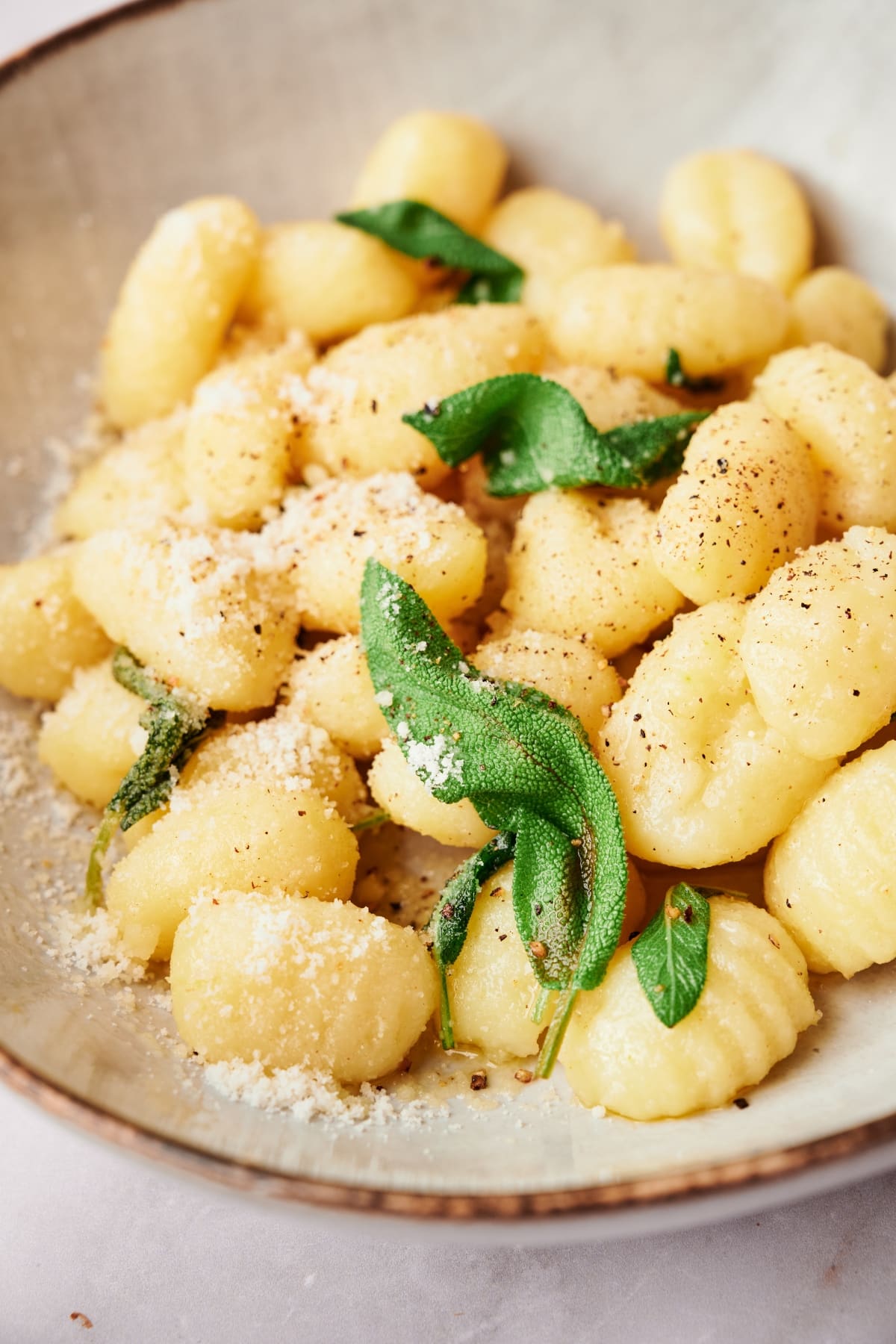
These tiny dumplings are usually made from just a few simple ingredients like potatoes, flour, eggs, and salt. They are then topped with a delicious sauce, from the simple butter and sage sauce to tomato sauce, cream, prosciutto, and much more.
The word “gnocchi” is a plural word in Italian. The singular form is “gnocco” [nyo-ko]. So if you are referring to a single dumpling, you should call it a “gnocco.” For instance, if a dumpling fell off your fork as you were shoveling gnocchi into your mouth you would say, “A gnocco just fell from my fork, but I’m still gonna eat it because there’s that 3-second rule. Right?”
In Rome, it is traditional to eat gnocchi on Thursdays. The locals call it Gnocchi Giovedi [nyo-ki jo-vi-di], which means Gnocchi Thursday. During this day, you will likely find a gnocchi dish on the “Specials” board of any restaurant within the city.
This easy homemade potato gnocchi recipe calls for just a few ingredients and just a few pieces of kitchen equipment, so you can make your own homemade potato gnocchi today!
Because you need to cook the potatoes first to make a sort of mashed potatoes, let them cool, and then, once you have made them, you have to let the gnocchi rest before cooking them. The entire process takes about an hour and forty minutes. However, these delicious gnocchi are worth the effort and the recipe is super easy to follow!
You almost certainly have all the ingredients you will need for this potato gnocchi recipe already in your pantry. Below is a list of the four simple things you will need to make this easy and fun homemade pasta that will make a delicious gnocchi meal just like you find at a 5-star Italian restaurant.
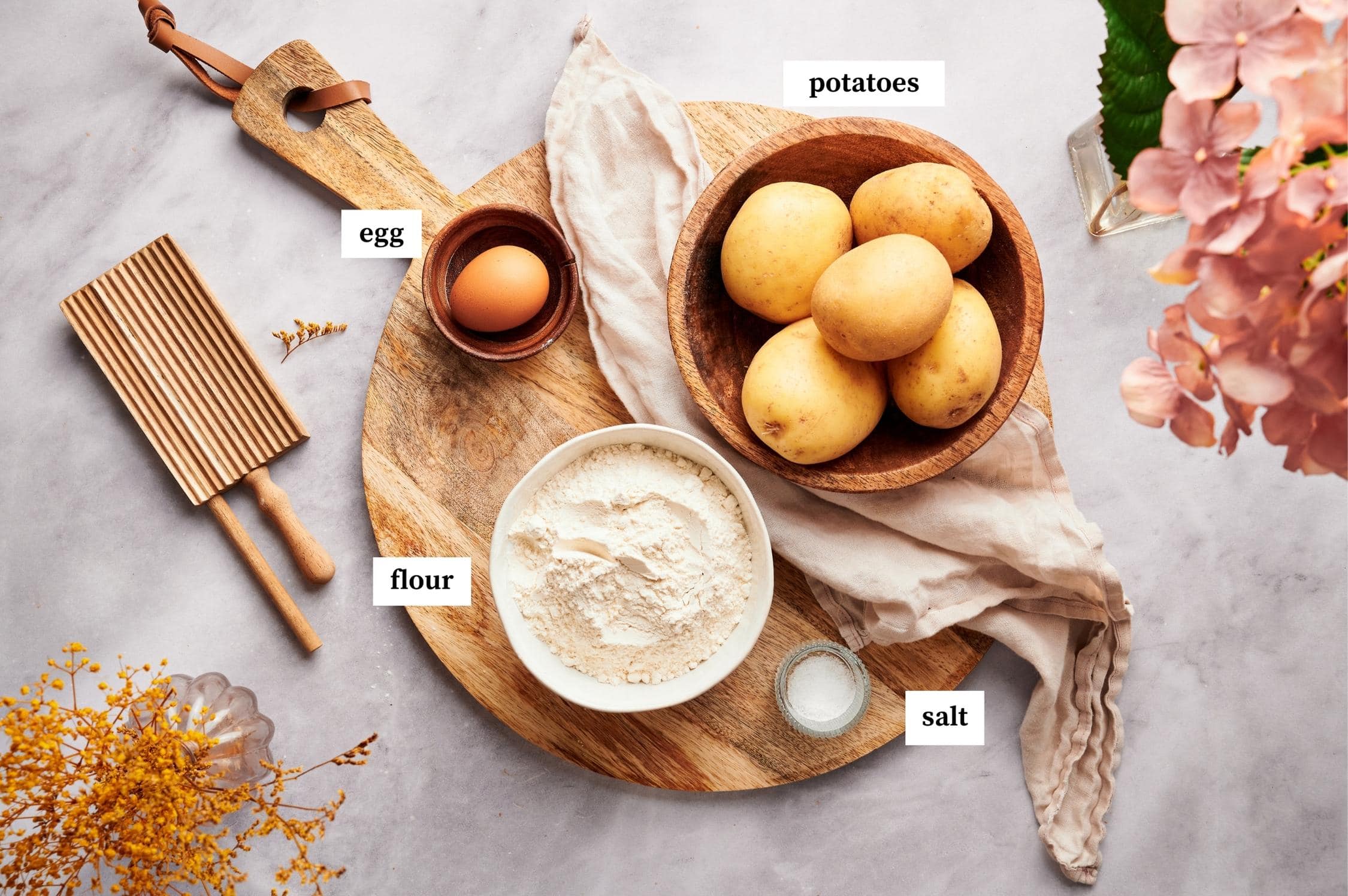
There are several steps to this recipe, but they are all easy to follow and totally do-able.
Wash and scrub the potatoes thoroughly (photo 1). Make sure to remove all dirt but leave the skins on.
In a large pot, put enough water to cover the potatoes when they are placed inside, and bring to a boil over medium heat (photo 2).
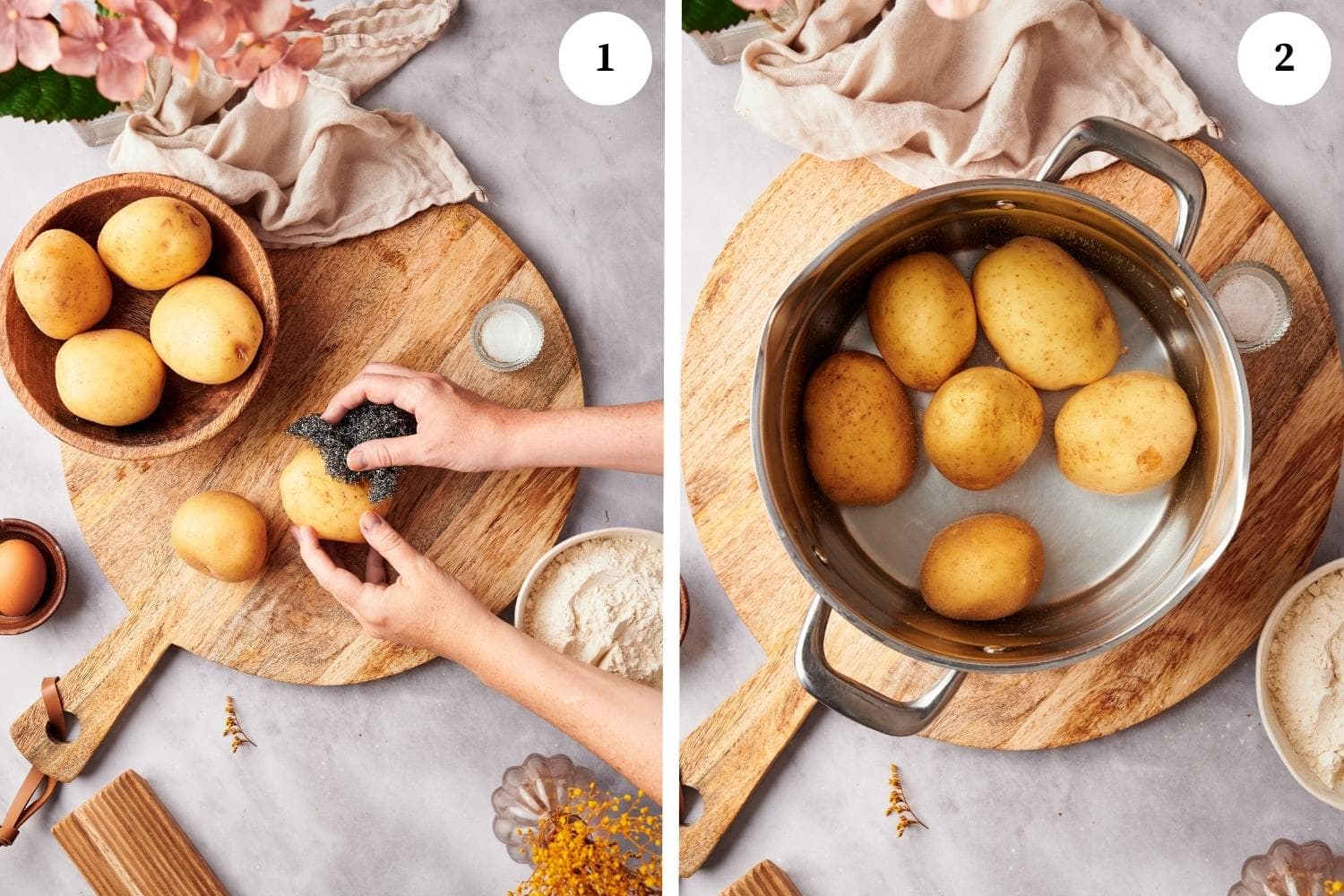
Boil for 25-30 minutes, or until the potatoes are soft enough so that they can be pierced easily with a fork.
Drain the potatoes and remove the skin while they’re still warm. If you have a potato ricer, you don’t need to peel them but you can.
Using the ricer, mash the peeled potatoes. Make sure to get rid of clumps but don’t over-mash. If you don’t have a ricer, mash the potatoes with the help of a fork (after removing the skins) (photo 3).
Let the potato mixture cool enough to handle. If you are not using the egg, let them cool for at least 30 minutes so they are chilled completely.
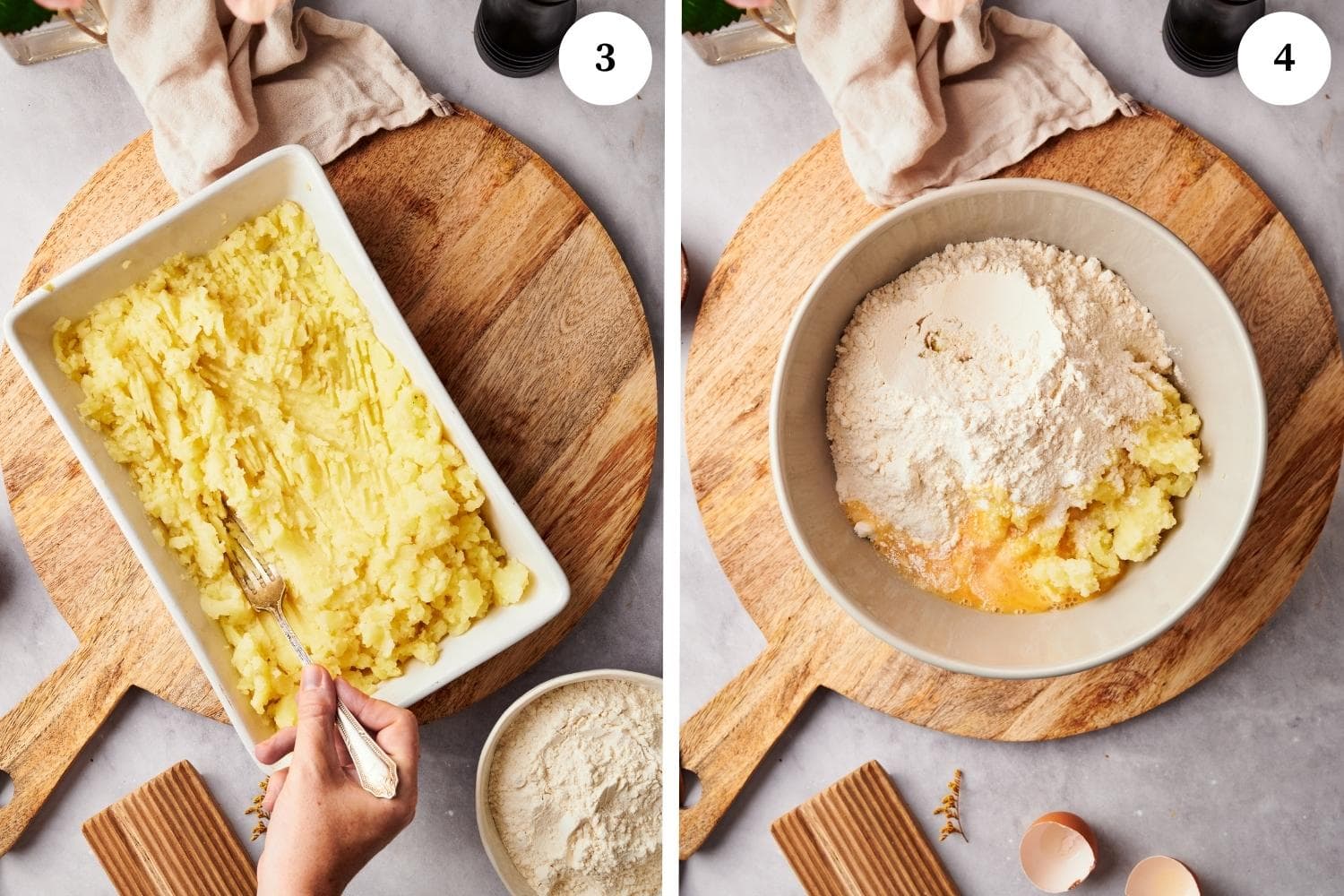
To make the dough, in a large bowl combine the mashed potato and flour.
Add the slightly beaten egg and mix into the potato and flour. Then, add a pinch of salt (photo 4).
Knead the ingredients together very briefly, just until you get a soft but firm, uniform gnocchi dough, and shape it into a ball. Do not over-mix.
Remove an eighth of the dough and cover the remaining dough so it doesn’t dry out.
On a lightly floured surface, and with some flour on your hands, roll the piece of potato gnocchi dough under your hands until it forms a long rope as thick as your thumb (photo 5).
Cut the rope into pieces of about 1 in / 2 cm, separating the gnocchi from each other (photo 6).
Repeat the procedure until you have used all the dough to make 1 in /2 cm squares.
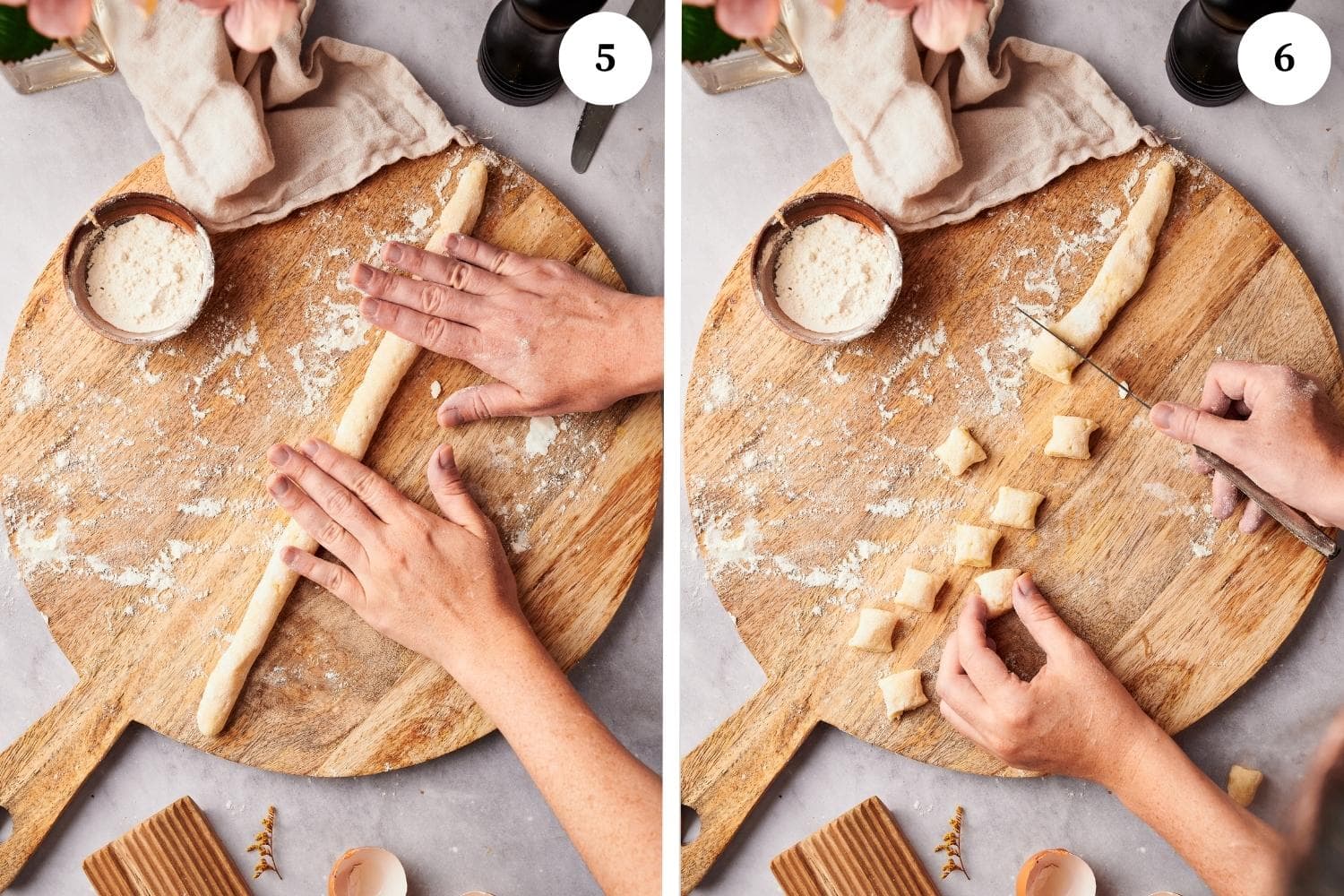
If you have a gnocchi board, you can use it to create the decorative shape of ridged gnocchi. To do so, use your thumb (or forefinger and middle finger together), press and roll each one gently downward to form the ridges. Do not push too hard or the dumplings will be misshapen.
If you don’t have a gnocchi board, you can use a floured fork to make the ridges. Dip a fork in flour and using the back of the tines, slowly roll the gnocchi down the back of the fork by applying gentle pressure with your thumb. Although you can also leave them smooth, we recommend making the ridges on the little dumplings because the sauce clings much better to them.
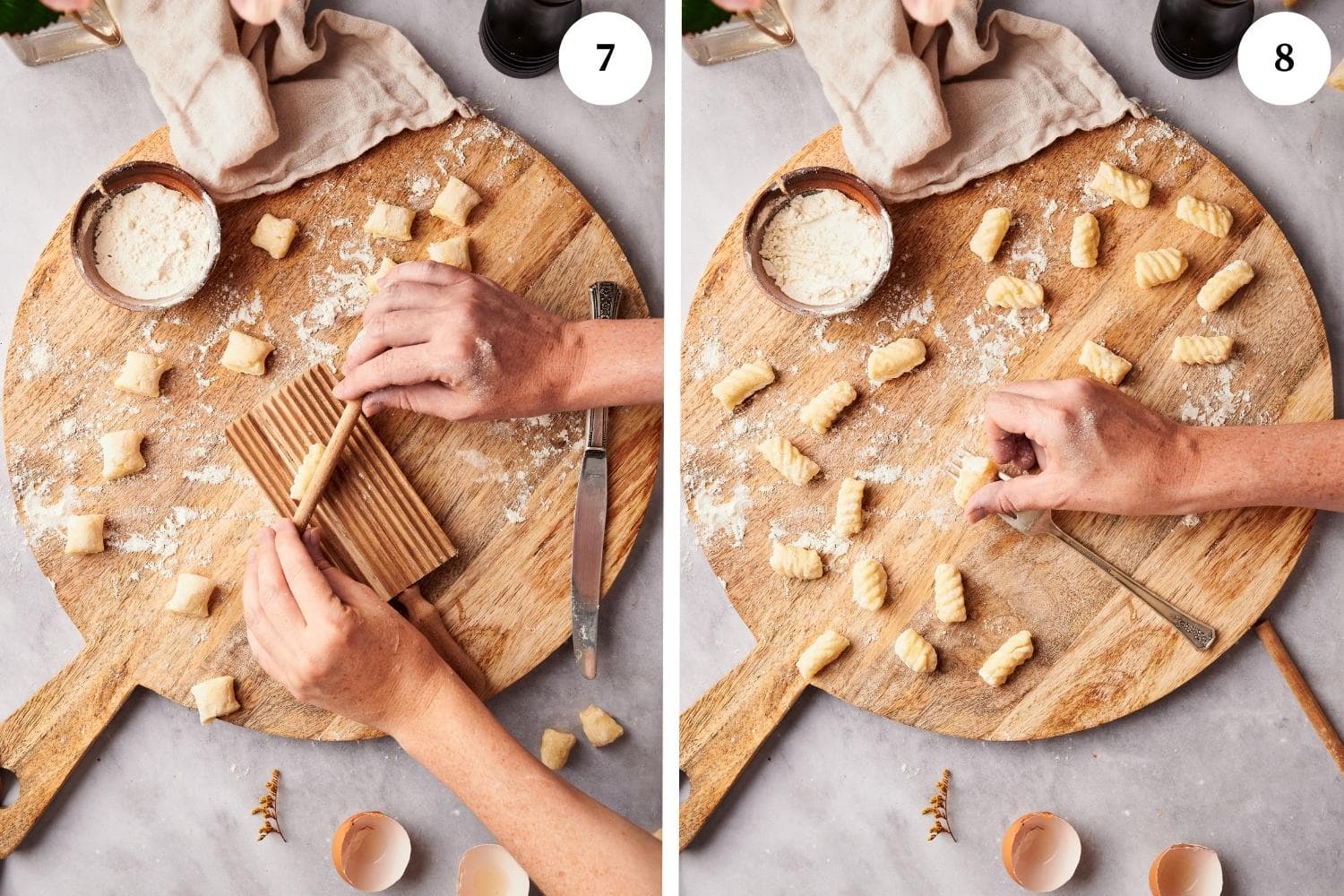
Place the finished pasta on a floured cutting board or tray (photo 9). Leave to air dry for about 20-30 minutes. If you did not use egg, this step is even more important and you should leave them to dry for an additional 20-30 minutes.
To cook, bring a large pot of salted water to a boil.
Gently place the dumplings into the boiling salted water, stirring gently to make sure they don’t stick to each other.
Boil for about 2 minutes, but not more than 3. When the dumplings start to float in the water, that means they’re almost done. Just give them another 25 seconds before removing them (photo 10).
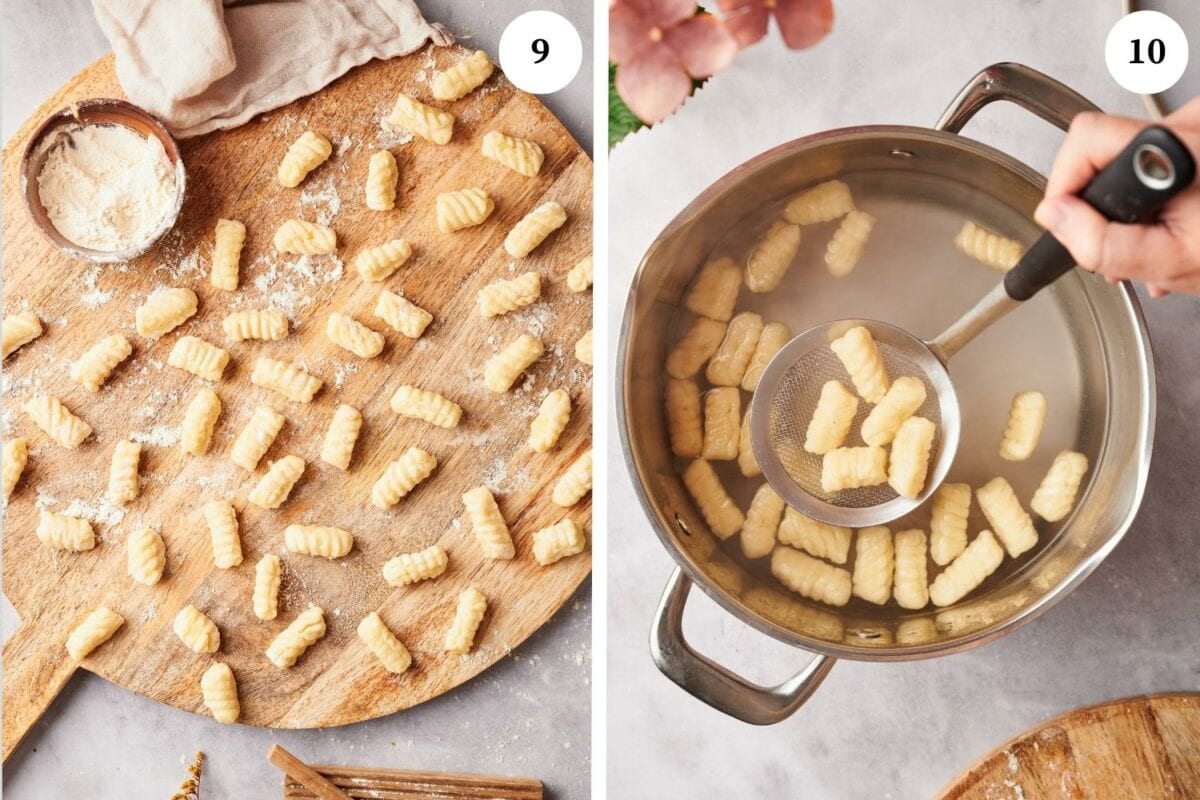
Remove them with a slotted spoon or small hand-help strainer and put the cooked gnocchi directly into the pan with the sauce you have prepared.
The best sauce is half a stick of melted butter or 1/4 cup of olive oil heated with 5 sage leaves in a large skillet until the sage gets a little crispy and the butter slightly browns. Once you have stirred the gnocchi in, top it with Parmesan cheese, Parmigiano-Reggiano cheese, or Grana Padano cheese.
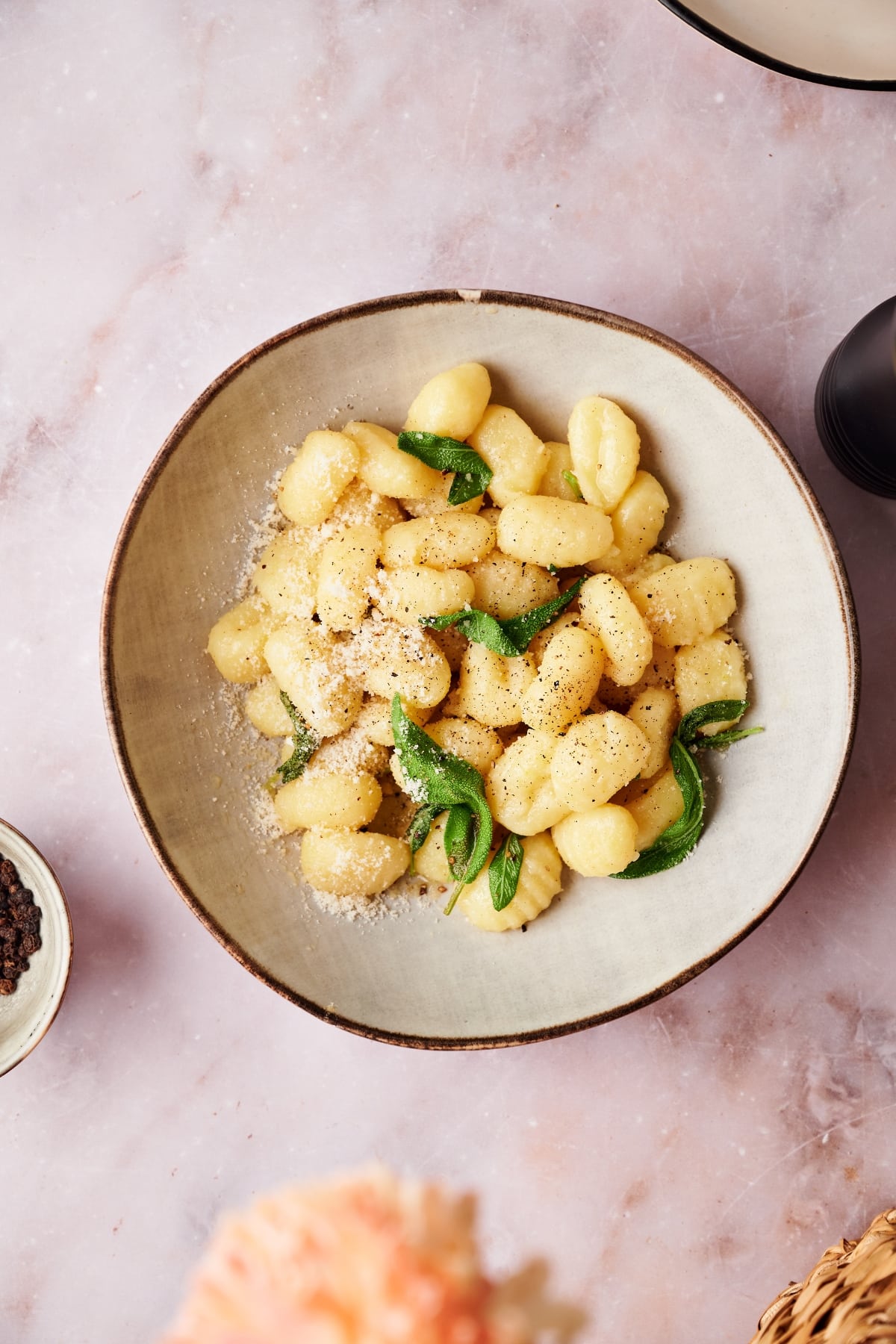
After you bring a large pot of boiling salted water to a boil, you will add the gnocchi and wait for about 2 minutes. When you see that the gnocchi have turned and risen to the surface count to 25 and then remove them with a strainer and place directly into the sauce to serve immediately.
Preparing the perfect potato to use to make this potato gnocchi recipe starts with choosing the right starchy potato, such as Russet potatoes or Yukon gold potatoes. You can then boil them with their peels on and then mash them with a ricer directly or peel the potatoes and smash them with a fork. Be sure to let the mashed potatoes cool before creating your homemade pasta with them.
We love gnocchi and the absolute best way to ensure you don’t end up with a falling apart mess when you put them in the boiling water is by letting them rest for 20-30 minutes if you follow this recipe, or for 40-60 minutes if you make the recipe without the egg.
Leftover cooked gnocchi should be drizzled with olive oil (unless they already have sauce on them) and then put in an airtight container for no more than 3 days in the fridge. You can then reheat them with a little oil or directly in a sauce and a little bit of water.
Yes, they can be frozen. Put the pasta on a flat tray or plate and freeze for a few hours, then transfer all to an airtight container or a plastic bag and store in the freezer for up to 3 months. When you want to use them, do not defrost, simply put the frozen gnocchi into boiling water and follow the instructions for straining and combining with the sauce.
So where did these yummy dumplings really come from? According to historians, the earliest recorded mention of gnocchi was in the 14th century in Italian cooking manuscripts from that time period.
But their origins were much earlier and perhaps date all the way back to when the Roman Empire was expanding its territory and soldiers conquering lands in the Middle East discovered a predecessor to modern day gnocchi and liked them so much they brought the recipe back to Italy.
The earliest versions of homemade gnocchi, especially in northern Italy, didn’t have potatoes at all until after Spanish explorers brought potatoes from South America to the European continent. Previously, the main ingredients to making gnocchi depended on the region and who was preparing it.
In some regions it was squash, in others it was breadcrumbs or semolina (durum wheat). Today, gnocchi is often made from semolina, all-purpose flour, wheat flour, breadcrumbs, and of course, potatoes.
Italian immigrants introduced gnocchi to South American cuisine during the early 20th century, and today it can be found in Brazilian, Venezuelan, Colombian, and Argentinian cuisines. As a matter fact, it is so popular in Argentina that they have declared the 29th of every month as Dia de Ñoquis, or Gnocchi Day.
The story behind the celebration is that every 29th of the month is considered a day when money is tight since people won’t get their salaries until the first day of the next month. Because this pasta doesn’t need many ingredients, and potatoes and flour were the last things to disappear from a kitchen larder, it was the perfect meal to make being both cheap and deliciously filling.
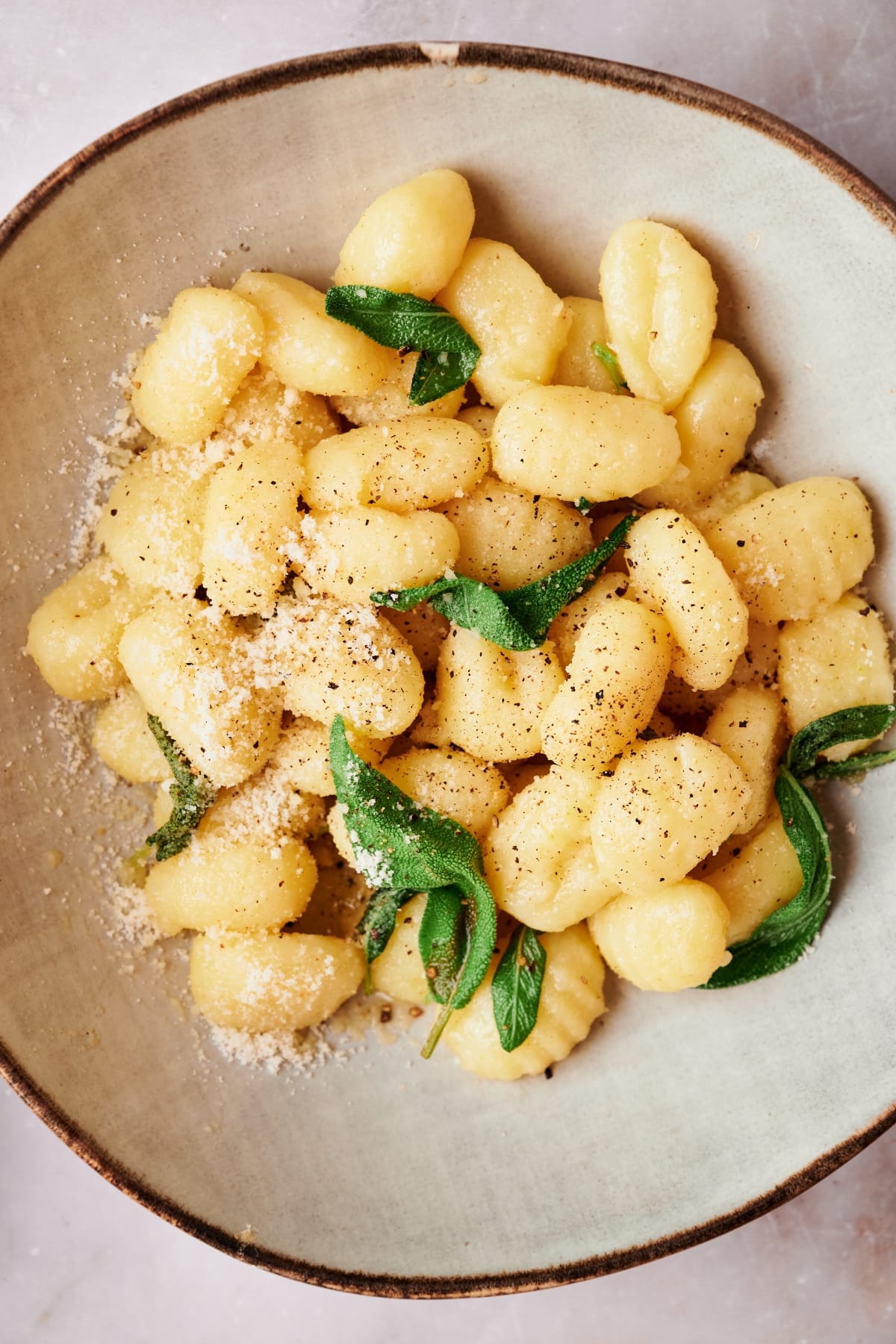
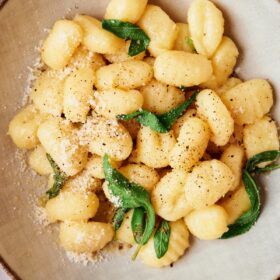
I tried this recipe yesterday doubling it and using yellow potatoes. It took so much more flour than the recipe required and the dough was still very sticky. The gnocchi were misshapen and not east to cut and roll. However, the taste was good but more like dumplings than gnocchi.
Ciao Colette – a lot depends on the type of potatoes, the water they absorb etc… It’s not unusual adding more flour if needed. Grazie mille!
Being Italian, I learned to cook a lot of dishes. However, gnocchi was not one of them. Thank you so much for posting this recipe. Especially, with the care and precision you took writing it, so it could be made correctly!
I feel confident mine will turn out beautifully!
Grazie mille Leona, glad you enjoyed it!